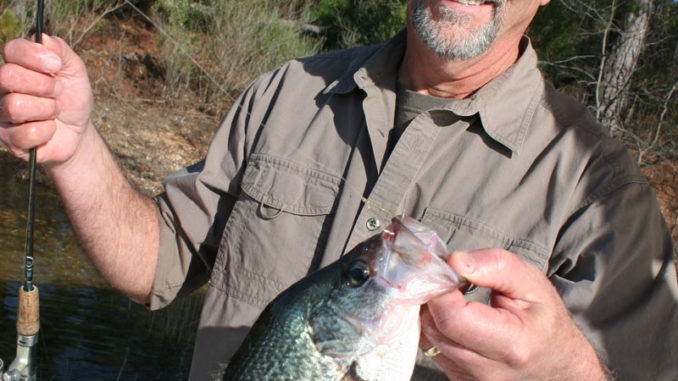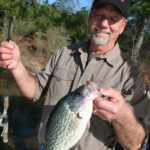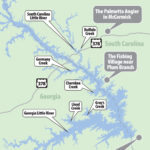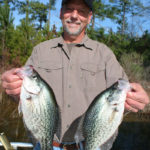
Docks and brush piles will hold plenty of Clarks Hill crappie this month.
Guiding on Clarks Hill Lake is a business for William Sasser, but crappie fishing takes him back to his childhood. Although most of the business of his guide service and bait shop centers on fishing for stripers and hybrids, it was his ability to catch crappie on the sprawling Savannah River reservoir that got him into guiding.
Sasser believes this could be a very good year for crappie fishing on Clarks Hill, aka Thurmond, an opinion bolstered by South Carolina fisheries biologists. Studies show the 2009 year-class was very strong in numbers, and those fish will reaching slab size this year: 10 to 12 inches long.
In addition, Sasser noted, heavy winter rains have put a lot of water into the Savannah River system.
“If the water level stays up like it is now, there might be a lot of cover to fish this year,” he said. “The crappie will be in the same areas of the lake they normally inhabit throughout the spring, just easier to locate.
“In late February and into March, the crappie are in two directions on Clarks Hill. One direction is South Carolina Little River and Buffalo Creek. In the mid-lake area, they will be in the backs of creeks and along the banks starting to spawn near the Fishing Village at Plum Branch,” Sasser said.
“You can pull jigs and catch crappie that time of year, but a lot of people fish from the bank with minnows, jigs, Hal Flies and Doll Flies with a cork in that part of the lake. Last February, Donna (his wife) and I rode up there in the car, and it was like Myrtle Beach. There were so many people fishing, you could hardly get on the bank to fish.”
Across the lake in Georgia Little River, the fish will still be deep over brush, Sasser said.
“They will be more in the coves and feeder creeks where we catch them in 25 to 30 feet of water fishing 15 feet down,” he said. “As it warms up in the evenings, the fish will move back to shallower water looking for places to spawn, and we catch them on the shallower brush, maybe 10 feet deep.”
As the weather continues to warm in March, Sasser said the fish will move even shallower, as little as two to three feet deep.
“There is a lot of Doll Fly fishing then, and we also catch them on things like Crappie Catcher jigs,” he said. “That time of year, I fish two ways. One way is to anchor in shallow water, 15 feet deep, and fish straight down with minnows. Other times, I will mark the tree and back off, then throw a slip-cork rig with a little jig past the tree and pull it back past the brush,” he said.
From late February through March, docks are prime locations to catch crappie on both sides of the lake, Sasser said.
“That time of year, you can just about catch a mess of crappie every day by going dock to dock and throwing jigs up under the docks and working them back. It’s very important to cast up into the docks and pull the jig back from shallow water past the docks. A lot of people put trees out around their docks, so you are actually fishing both dock cover and tree cover.”
“Then in late March into April, you can fish the banks with Doll Flies and Popeye corks, and this is probably going to be a really good year for that if they keep the water level up.”
By April, Sasser concentrates on Georgia Little River, fishing the backs of the main feeder creeks: Cherokee, Grays, Lloyds and Germany.
“I mainly fish shallow trees in the mouths and the backs of the coves, and then as May goes on, I just get deeper in the backs of the same creeks, 20 to 25 feet deep,” he said.
For many anglers, Clarks Hill’s crappie seem to just disappear in June and July as they move out of the creeks when the water quality starts to go bad in those areas.
“By June, I am fishing in open water in the middle of the lake,” he said. “They move out there closer to the main rivers, but they actually go back up shallow in 15 to 18 feet of water. It is mainly brush pile fishing with minnows out there.”
Sasser has solid credentials to go with his knowledge of crappie fishing on Clarks Hill. His personal best was a 31/2-pound fish caught on a Popeye jig in March 1978. The biggest crappie caught by a fishermen on one of his guide parties weighed a whopping 41/4 pounds; it hit a live minnow fished over a brush pile in the spring of 2008.
But perhaps more significant is his personal record of catching more than 50 crappie, all over two pounds, fishing minnows over treetops in the summer.
The most enjoyable thing about crappie fishing, he said, is that it allows him to remember his childhood on Clarks Hill.
“I had a crazy fishing father when I grew up (in Augusta),” Sasser said. “He dragged me everywhere he went: crappie fishing, largemouth fishing, trout and spot-tail fishing on the coast, deep-sea fishing, freshwater, saltwater, offshore, inshore. He was pretty hard core.
“He did exactly the same thing I did, he took everybody fishing all the time, but not for money.”
Sasser began guiding almost by accident.
About 10 years ago, Sasser, who has owned an automobile transmission shop for 36 years, did a fishing show with Bill Baab, the fishing editor for an Augusta newspaper.
“I put them on some fish, and we caught a hundred crappie that day. That night Bill called me and said, ‘Why don’t you try being a fishing guide?’ He gave me a spot in the Friday Fishing Report, and I jumped from building transmissions to literally fishing every day.”
DESTINATION INFORMATION
HOW TO GET THERE — US 378 runs from McCormick across South Carolina Little River and the Savannah River to Lincolnton, Ga. SC 28 runs along the east side of Thurmond Lake from McCormick to the Clarks Hill community. US 221 runs west from Clarks Hill across Thurmond Lake Dam into Georgia, where it picks up GA 47, which crosses Georgia Little River and runs up the west side of the lake to Lincolnton. Boat access areas are scattered up and down the lake. To locate them, visit www.dnr.sc.gov/mlands/boatramp/?p_type=335836.
TACKLE/TECHNIQUES — Medium-action spinning tackle with 8-pound test for fishing brush piles, 6-pound test for pulling jigs. Tie on a No. 1 Aberdeen hook with No. 7 or No. 5 split shot for live minnows. Rig jigs straight or with a slip-cork for casting. Also, work jigs under and alongside docks.
GUIDES/FISHING INFO — William Sasser, Sasser’s Guide Service, 706-589-5468; the Herring Hut, Clarks Hill, 864-333-2000; the Palmetto Angler, McCormick, 864-852-3373. See also Guides and Charters in Classifieds.
ACCOMMODATIONS — McCormick County Chamber of Commerce, 864-852-2835, www.mccormickscchamber.org/.
MAPS — Kingfisher Maps, 800-326-0257, www.kfmaps.com; Fishing Hot Spots, 800-ALL-MAPS, www.fishinghotspots.com; U.S. Army Corps of Engineers, www.sas.usace.army.mil/About/DivisionsandOffices/OperationsDivision/JStromThurmondDamandLake/PlanaVisit/BrochuresMaps.aspx.




Be the first to comment